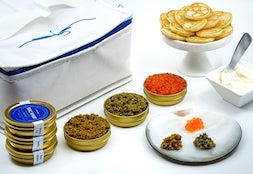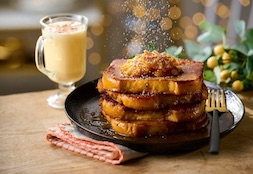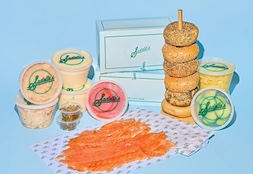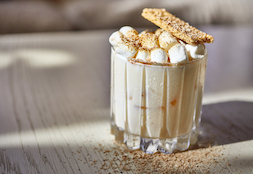He is wearing a bowtie, is the first thing. Then there’s the rectangular wooden box, which he places on a black table under sparking chandeliers. And finally, I spy the two bottles of Veuve Clicquot, dunked lip-first into an ice bucket behind us, waiting like sitting ducks for their ceremonious uncorking.
It would appear that, uh-huh,this is the man I’ve come to see. This is the champagne saberer, the master swordsman (sabersman?) himself, the bon vivant who has perfected the fanciful art of sabrage.
His name is Will Rentschler, and he’s actually a pretty friendly dude. Absent is the self-seriousness you’d expect to find hovering around a person who refuses to open expensive French bubbly the normal way, opting instead to deploy bona fide kitchen swords.
He is certainly not as intimidating as the French Hussars, whom internet historians suggest first developed the practice, way back during the Napoleonic Wars. The weapon of choice for these well-dressed soldiers was the saber. As they rode gallantly through towns on horseback, the proud denizens would toss them bottles of champagne—because, France—and rather than deal with the tedious process of undoing the cages surrounding the cork, the Hussars would nonchalantly slice them open with their sabers and be on their merry way.
The St. Regis Hotel in New York, where Rentschler occupies the role of both Champagne Saberer and Food & Beverage Director, has its own storied history when it comes to sabrage. I caught up with him last Friday at the hotel to discuss the ritual, his exceptional technique and more.
This is the UD Job Interview.
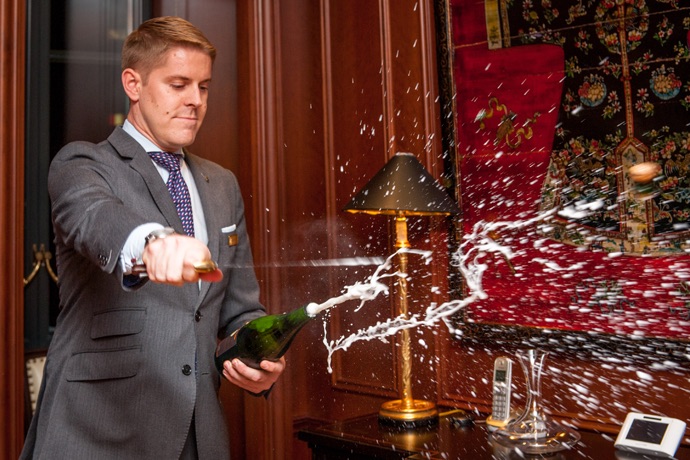
How long does it take for one to become a master champagne saberer?
Rentschler has been slicing corks off bottles of fine champagne for about five years now, though only the last two in a professional capacity. He was, as many are, self-taught. In all honesty, it’s fairly easy to saber champagne; anybody can do it with the right tools and instructions (including your humble correspondent). But, as with any other activity, particularly one involving a relatively rote motion, repetition is key, practice makes perfect, etc, etc...
How much practice does the St. Regis champagne saberer get, exactly?
Back in the early 1900s, the hotel’s founder, John Jacob Astor IV, would saber a bottle of champagne nightly, to celebrate the transition from day to night. Around two years ago, Rentschler re-implemented this tradition. Meaning: he’s sabered a bottle pretty much every night for the last 730 days, in the salon near the hotel’s historic King Cole Bar. This doesn’t include special occasions, or the private lessons he began giving at the behest of the hotel. In other words: he gets a lot of practice.
Are there sabers made specifically for champagne? What are they like?
The short answer is yes, though a kitchen knife would do in a pinch. The St. Regis actually had one made exclusively for them by Christofle—an iconic French silversmith. However, Rentschler reserves that saber for special occasions. His saber for daily use was made in California. It’s more or less the size of a kitchen knife; the primary difference is its dull blade.
Wait, why would the blade be dull?
It’s dull, Rentschler explains, because you’re essentially using the saber more like a hammer than a blade. Effectively, all the work is done by a two-inch or so section of the saber near the hilt.
Huh?
You’re breaking the glass, not cutting it.
This is probably the part where you should just explain how a master champagne saberer actually sabers champagne.
First thing’s first: you need real champagne, not knock-off champagne, for reasons involving the thickness of the glass (for similar reasons, avoid sabering magnums). You’ll want to cool the bottle for a while before sabering, but with the neck facing down. Cooling the bottle makes the glass more brittle—and you’ll want the glass near the neck to be especially brittle, because that’s where the action’s happening.
When you’re ready to go, undo the cage surrounding the cork and hold it firmly in your weak hand. Make sure nobody is in the line of fire (this is Rentschler's first rule). Then rub your finger across the bottle until you find a seam. Champagne bottles are constructed from three pieces of glass—two for the body, and one for the lip; the seam where they’re forged together is its weakest spot. Think of it as your runway.
Hold the bottle up to about your navel. Line the two-inch section of the blade closest to the hilt with the seam. The saber should be at about a 45-degree angle with the glass. With a swift motion—think of your elbow as a lever, Rentschler says—run the saber up the seam.
The blade should break the top of the glass off with a resounding thwack. You’ll want to have some glasses ready...
What’s the most common mistake normal people make when sabering champagne?
When people screw up, Rentschler observes, it’s often because they don’t remember to follow through. No matter who you are, you’re going to feel a little nervous sabering a bottle for the first time; something about wielding a weapon to break glass, resulting in a loud sound, tends to gets the juices flowing. Also: this champagne isn’t cheap. So people tense up. (Your humble correspondent can confirm.)
Think of your champagne sabering motion as you would a golf swing or tennis stroke. Staying loose and following all the way through is key.
This all sounds relatively simple. Can’t anyone be a champagne saberer?
According to Rentschler, it’s the job of people like him to make the hard things look easy and the easy things look hard.
Take that as you will.


